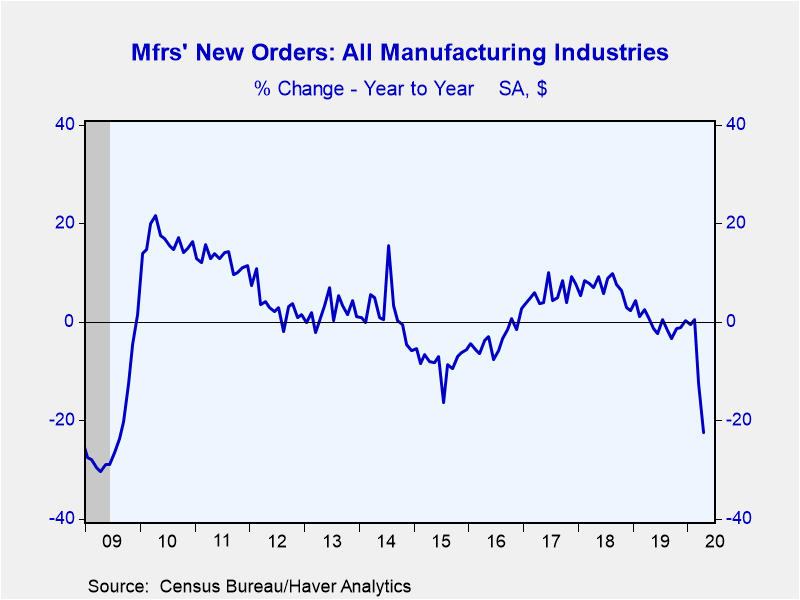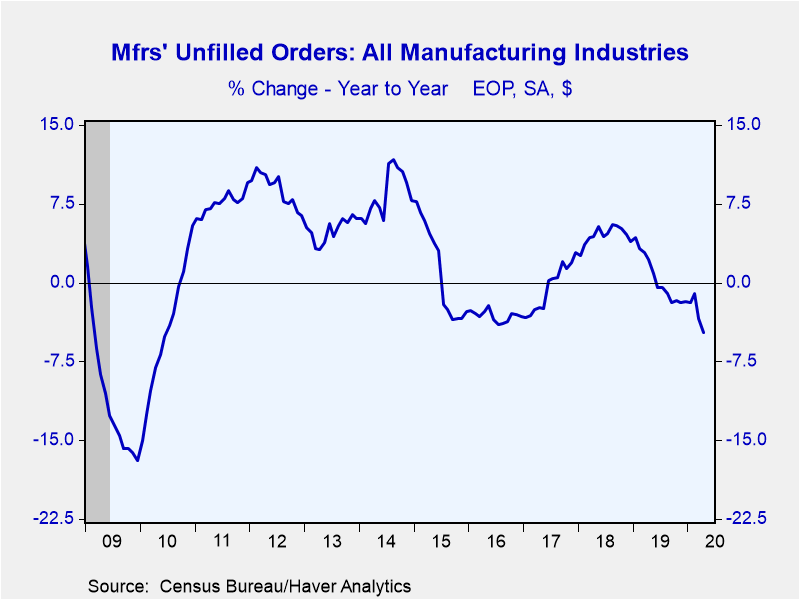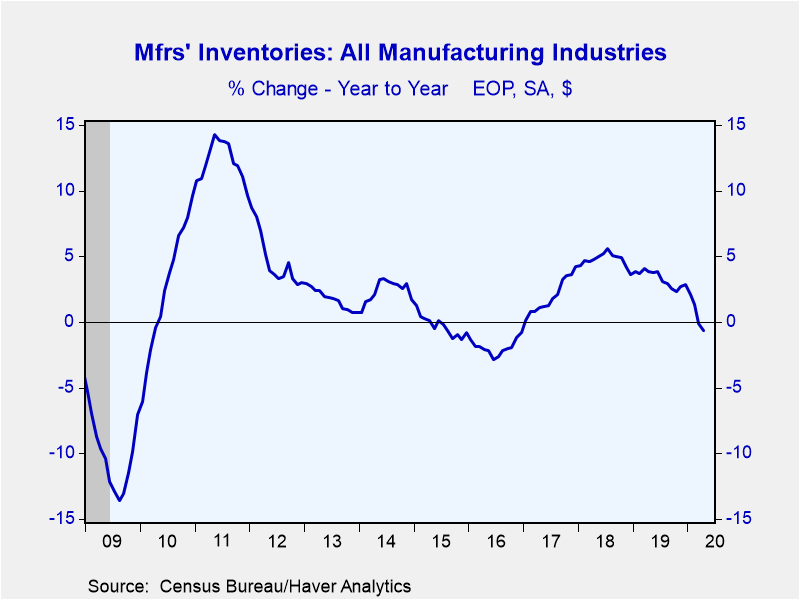 Global| Jun 03 2020
Global| Jun 03 2020Even Larger Decline in U.S. Factory Orders and Shipments in April
by:Sandy Batten
|in:Economy in Brief
Summary
• A second large factory orders decline led by durable goods. • Shipments fall even more in April than in March. • Inventory liquidation continues--in nondurable goods. U.S. factory orders and shipments posted even larger declines in [...]
• A second large factory orders decline led by durable goods.
• Shipments fall even more in April than in March.
• Inventory liquidation continues--in nondurable goods.
U.S. factory orders and shipments posted even larger declines in April than they had in March as the widespread economic lockdown took a larger toll. Orders slumped 13.0% m/m (-22.3% y/y) in April on top of a downwardly revised 11.0% m/m decline in March (originally -10.3% m/m). However, the April decline in orders was not as bad as the market had expected--the Action Economics Forecast panel had looked for a 14.0% m/m drop. The drop in shipments in April was even steeper than both their decline in March and the April decline in orders. Shipments plummeted 13.5% m/m in April (-18.9% y/y) following a 5.5% m/m decline in March.
As in March, the April weakness was led by a sharp decline in durable goods orders which again reflected a collapse in transportation orders. Orders for durable goods fell 17.7% m/m (-29.8% y/y) in April after a 16.7% m/m drop in March. Transportation orders plummeted 48.3% m/m in April following a 43.2% monthly plunge in March. In March and April transportation orders were down a whopping 71%. Durable goods orders fell in every major category. However, orders for computers were down only 0.1% m/m. Orders for nondurable goods, the really new information in this report, slumped 9.0% m/m (-15.3% y/y) in April, an even bigger decline than their 5.4% m/m drop in March.
The increased weakness in shipments in April was also led by shipments of durable goods which fell 18.2% m/m (-22.7% y/y) after a 5.5% m/m decline in March. Again transportation was the major factor. Transportation shipments fell 43.1% m/m in April with shipments of automobiles plummeting 91.7% m/m. Shipments of nondurable goods were also weak, but less so than shipments of durables. Nondurable shipments fell 9.0% m/m (-15.3% y/y) in April due mostly to a drop in petroleum shipments. The 32.0% m/m fall in petroleum shipments accounted for more than one half of the April decline in total shipments of nondurables.
Unfilled orders for manufactured products fell 1.6% m/m (-4.8% y/y) in April on top of a 2.1% m/m decline in March. Transportation sector backlogs declined 2.0% m/m. Excluding transportation, unfilled orders eased 0.5% m/m.
Factory sector inventories fell in April for the fourth consecutive month, declining 0.4% m/m (-0.6% y/y) in April. Inventories of durable goods rose 0.2% m/m (3.2% y/y) following a 0.5% m/m increase in March. In contrast, inventories of nondurable goods declined 1.2% m/m (-6.3% y/y) on top of a 3.5% m/m drop in March, the largest monthly decline in more than a decade.
The factory sector figures are available in Haver's USECON database. The expectation figure is in the AS1REPNA database.
| Factory Sector (% chg) - NAICS Classification | Apr | Mar | Feb | Apr Y/Y | 2019 | 2018 | 2017 |
|---|---|---|---|---|---|---|---|
| New Orders | -13.0 | -11.0 | 0.2 | -22.3 | -0.5 | 7.3 | 5.7 |
| Shipments | -13.5 | -5.5 | -0.4 | -18.9 | 0.7 | 6.9 | 5.0 |
| Unfilled Orders | -1.6 | -2.1 | 0.3 | -4.8 | -2.1 | 3.9 | 1.9 |
| Inventories | -0.4 | -1.1 | -0.4 | -0.6 | 3.1 | 3.5 | 4.5 |
Sandy Batten
AuthorMore in Author Profile »Sandy Batten has more than 30 years of experience analyzing industrial economies and financial markets and a wide range of experience across the financial services sector, government, and academia. Before joining Haver Analytics, Sandy was a Vice President and Senior Economist at Citibank; Senior Credit Market Analyst at CDC Investment Management, Managing Director at Bear Stearns, and Executive Director at JPMorgan. In 2008, Sandy was named the most accurate US forecaster by the National Association for Business Economics. He is a member of the New York Forecasters Club, NABE, and the American Economic Association. Prior to his time in the financial services sector, Sandy was a Research Officer at the Federal Reserve Bank of St. Louis, Senior Staff Economist on the President’s Council of Economic Advisors, Deputy Assistant Secretary for Economic Policy at the US Treasury, and Economist at the International Monetary Fund. Sandy has taught economics at St. Louis University, Denison University, and Muskingun College. He has published numerous peer-reviewed articles in a wide range of academic publications. He has a B.A. in economics from the University of Richmond and a M.A. and Ph.D. in economics from The Ohio State University.










